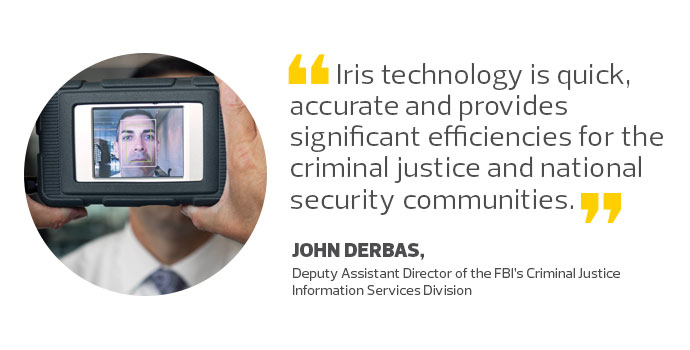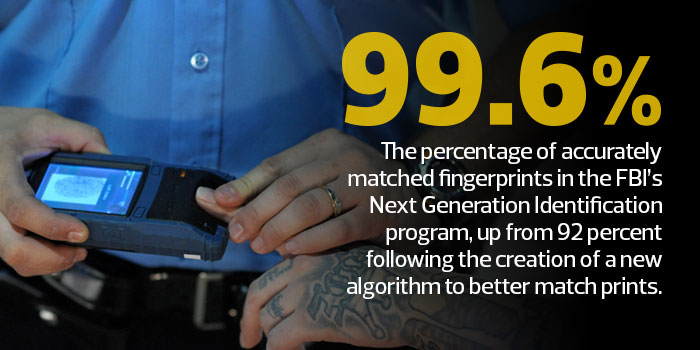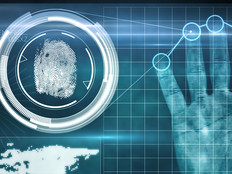The FBI’s Biometric Center of Excellence Peers into Future of ID Technology
For the past three years, the FBI’s Biometric Center of Excellence (BCOE) in Clarksburg, W.Va., has researched, developed, evaluated and standardized iris recognition technology as part of an innovative pilot program.
“Iris technology is quick, accurate and provides significant efficiencies for the criminal justice and national security communities,” says John Derbas, deputy assistant director of the FBI’s Criminal Justice Information Services Division. “Within seconds, current pilot participants can submit iris images and receive a response with wanted, warrant or sex offender information, along with gang affiliations of the person scanned.”
With complex and random patterns, the iris (the part of the eye that controls the amount of light that enters) provides an identification marker more accurate than fingerprints.
Iris scanning technology will likely soon become the biometric identifier of choice for law enforcement agencies, providing federal, state and local officials with a quicker and more accurate way to identify suspects.
Created in 2007, the BCOE serves as the FBI’s center to explore and advance the use of biometric technologies and capabilities. This includes improving and standardizing more mature processes, such as iris scanning, as well as developing experimental technologies such as “contactless” fingerprints.

The range of biometric technologies falls on a broad spectrum that includes palm prints, voice recognition, handwriting analysis and DNA. The center also acts as the government’s biometric leader, helping coordinate biometric projects across agencies to avoid duplicating their efforts.
As biometric technologies become more commonplace, the BCOE serves an important role inside government. The center’s staff certifies for federal use various biometric products, including printers, scanners and mobile identification devices; in addition, the center creates standards for biometric use in government, with a goal of making biometric technologies part of an agency’s operations.
Identifying New Technologies
To determine which biometric technology to study, BCOE researchers consult with stakeholders, such as federal, state and local law enforcement, on current or future needs. Sometimes BCOE leaders get cues from agencies that already have products in use, academic research projects or the biometrics market itself.
Nick Megna, the BCOE’s unit chief, says the FBI first looks for commercially available tools to meet stakeholder needs. If such products are not available, BCOE researchers either issue a challenge to the agency’s academic partners or develop software in-house. However, in-house development is not the agency’s top choice. “The FBI prefers not to be in the software business,” he says.
The Iris Pilot highlights the BCOE’s core mission and operating procedures.
Launched in 2013, the pilot serves as a collaboration between the FBI and the center’s major partners, including the National Institute of Standards and Technology (NIST); West Virginia University, which serves as cooperative lead for contributions from 33 academic institutions; the departments of Defense and Homeland Security; and state and local law enforcement.
The Iris Pilot is just a part of the larger FBI Next Generation Identification system, which brings together the world’s largest and most efficient electronic repository of biometric and criminal history information.
Making Standards Interoperable
Shahram Orandi, chief of NIST’s Information Access Division, says the BCOE’s standards developers work within budget and technology limitations to provide agencies that could benefit from advanced biometrics with a workable solution.
“The most important thing we can do is make these standards interoperable and backward-compatible,” he says.

SOURCE: FBI, Next Generation Identification system
For instance, the BCOE and NIST collaborated on the Integrated Automated Fingerprint Identification System, setting a 1,000-pixels-per-inch standard for fingerprint scans. To ensure a large user base, the BCOE and NIST guaranteed that agencies using 500-pixel-per-inch devices, including cameras, printers and scanners, could still access and utilize information.
The higher resolution enables law enforcement and forensics teams to capture and analyze intricate details of latent fingerprints, including pores and incipient ridges.
“The biggest problem law enforcement has is that their budgets are flattened yet their jurisdictions are getting larger, and they have no additional resources,” Orandi says. “Our work helps show them how they can extend their resources.”
Ensuring interoperability up front saves agencies from the need to integrate technology afterward. “We eliminate large problems on the back end,” Megna says.
Beyond Fingerprints
Along with iris scans, the BCOE works with a number of different biometric identifiers, including facial recognition, voice tracking and even handwriting analysis.
As excited as Megna and Derbas are for their current project list, they say upcoming efforts, such as contactless fingerprints, will be game changers. Contactless fingerprint readers can capture an accurate fingerprint reading without requiring the test subject to physically touch the device.
Contactless fingerprinting has the potential to process pandemic victims without requiring them to share potentially contaminated samples.
The technology could also improve the intake process for inmates at correctional institutions.
Some other current and future projects include:
- Tattoo recognition. The BCOE is conducting a Tattoo Recognition Technology–Challenge for commercial and academic communities to advance research and development into automated, image-based tattoo-matching technology.
- Mug shot quality. To improve mug shots capture, the BCOE plans to promote best practices law enforcement agencies can use to improve the quality of facial recognition searches.
- Digital video recorder standards. The BCOE is standardizing the manner in which information is stored on DVRs so that when events such as robberies occur, law enforcement can easily access a store or bank’s DVR data.
The BCOE also studies the benefits of roadside mobile identification attached to rapid search capabilities, so officers can quickly identify the person in front of them. “They’ll be able to know if the person is wanted or potentially armed,” Derbas says, adding this information could save lives.
So far, the Iris Pilot has shown success at correctional institutions that conduct iris scans upon releasing inmates. In 3 percent of cases, scanned inmates had unknown warrants for crimes in other jurisdictions, Derbas says. The program ensured the inmates were not released while being sought for other alleged crimes.
That’s just one of many projects, but as the BCOE’s work grows, so will biometric use in agencies.








